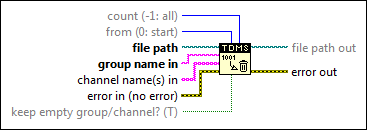 |
count specifies the number of data samples to delete from the .tdms file for each channel. The default is -1, which means this function deletes all data samples from the position you specify in from. If the value of count is out of range for a channel, this function automatically sets count to the number of data samples in that channel.
|
 |
from specifies from where to delete data samples from the .tdms file for each channel.
| 0 | start (default)—Specifies to delete data samples from the beginning of each channel. | | 1 | end—Specifies to delete data samples from the end of each channel. |
|
 |
file path is the absolute path to the file you want to open.
|
 |
group name in specifies the channel group on which to perform the operation.
|
 |
channel name(s) in specifies the channel to perform the operation on. If you do not wire data to this input, LabVIEW performs the operation on all channels under the same group.
|
 |
error in describes error conditions that occur before this node runs. This input provides standard error in functionality.
|
 |
keep empty group/channel? specifies whether to keep the group or channels in the .tdms file if the group or channels are empty after this function deletes data samples. The default is TRUE, which means this function keeps the empty group or channels.
|
 |
file path out returns the path of the .tdms file on which you performed the operation.
|
 |
error out contains error information. This output provides standard error out functionality.
|


 Add to the block diagram
Add to the block diagram Find on the palette
Find on the palette








